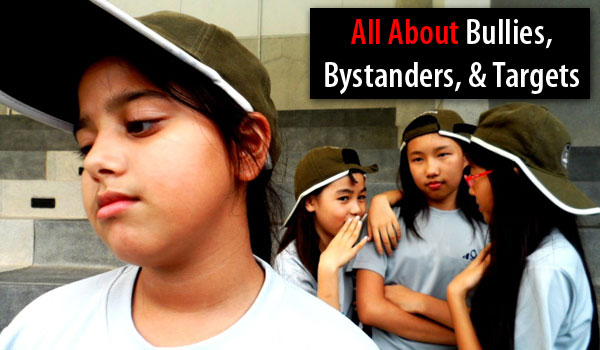All About Bullies, Bystanders, & Targets
Story by Nancy Driscoll, a psychologist with Triangle Psychological Services in Cary. Photo by 24students.
Cary, NC – With the start of a new school year comes new bus rides, classes friendships and unfortunately conflicts like teasing and bullying. Here’s a guide to taking action.
Clearly, some level of conflict in children’s lives is to be expected. Experiencing, and working through, conflict is an important part of growing up. We develop resilience, communication skills, and empathy in our experiences with others.
So when do normal childhood conflicts become “bullying”? Peer victimization is increasing at an alarming rate. A 2010 study by Josephson Institute Center for Youth Ethics surveyed over 40,000 high school students and found that nearly 50% reported being bullied and 50% reported engaging in bullying behavior.
The Four Hallmarks of Bullying
1. Intent – Children often speak or act without thinking, hurting someone in the process. Bullying, however, is the intentional infliction of physical or verbal harm. Impulsive behavior that hurts others can be followed by an apology and a resolve to think before acting next time. Bullying tends to continue, even when the bully is asked to stop
2. Repetition – While impulsive acts or true accidents happen from time to time, bullying becomes repetitive. The target tends to be someone the bully perceives as unable or unwilling to seek help. The bullying continues – because it can.
3. Hurtfulness – Bullying is intended to be hurtful, either physically or emotionally or both. Bullying among girls, often referred to as “relational violence”, is designed to inflict social harm – to reduce social status. This form of bullying often extends to cyberspace, becoming “cyberbullying”. Social media is used to belittle, embarrass, humiliate, or tease someone through the use of posted images, comments, or texts.
4. Power Imbalance – While a good deal of “give and get” is apparent among children who are arguing or teasing each other, bullying creates in the bully a sense of heightened power, and in the target a sense of powerlessness. Whether the power stems from size, age, social standing, or other factors, the goal of a bullying relationship s to make one person a winner, and one a loser.
What Can Parents Do?
As a parent, it is often difficult to know if, and when, to intervene in children’s struggles. Spouses may disagree. Children may insist parents “stay out of it!” Parents often fear they will “only make it worse” by confronting the bully or parent.
It may be hard to accept that their child is the bully, the target, or that she chose not to defend a targeted child. Even innocent bystanders are really not so innocent if they look the other way. Research suggests that bullying in schools is a group process. Even if the majority of children in a class are not participating actively in bullying, they often play a passive role that results in ongoing bullying. To a bully, lack of intervention is interpreted as support.
What can you do? What should you do if you feel your child is a target, bully, or bystander?
Ten Tips to Stop Bullying
1. Listen to your child, ask questions, and offer unconditional support and solutions. Be aware of signs that your child is being bullied: sadness, anxiety, or fear – especially regarding school or social situations; declining grades or loss of interest in school; changes in friendship status; being excluded or refusing to interact with friends. Support a child who, because of perceived differences, e.g. weight, lack of athleticism, being an “alternative thinker/nerd”, disability, etc. may become a bullying target.
2. Monitor your child’s online behavior on a regular basis and limit access to social media.
3. Teach your child digital safety skills such as:
- If your child has received hurtful messages through social media, eliminate their access to it. Many children simply don’t think to “just turn it off”. Instead they read and reread the hurtful messages and the victimization continues.
- Make sure your child understands that cyberbullies are not anonymous; perpetrators can be identified, and that criminal charges are possible. This includes making, storing, or distributing certain images.
4. Encourage empathy, awareness, and effective decision making. Praise instances in which your child shows empathy, helps others, and promotes friendships with diverse groups.
- Am I being kind and respectful to others?
- How would I feel if I received a negative message, threat, or text?
- What would my parent or other trusted adult think of my behavior?
- Am I behaving in a way that I can be proud of?
5. Encourage your child to report bullying, threats, or distressing messages. Encourage your child to stand up for what’s right and intervene to support a bullied child.
6. Do not tolerate hurtful or critical comments about others.
7. Model charity and kindness toward everyone.
8. Teach resilience. Encourage communication, positive affirmations, and a focus on positive qualities and interests.
9. Make clear rules against and set immediate consequences for bullying behavior. Be aware that children who bully are more likely to engage in other high-risk behaviors, do poorly in school, and become involved with the legal system.
10. Consider professional support for your child, whether as a bully or a target. Working on issues such as anger management, social and communication skills, anxiety, etc. with a trusted professional can provide the vehicle for a happier, more successful, life.
Zero-Tolerance Policy
Every child deserves a happy childhood, one with as little stress, fear, and anxiety as possible. Bullies, their targets, and the bystanders who witness such behavior all need help and support. Children who bully need the help of caring adults to establish appropriate peer relationships, control their anger, and develop empathy. The targeted child needs to build self-confidence, become more assertive, and identify and use his many strengths. The bystander must be encouraged to speak up when someone is being hurt or belittled; staying silent is not acceptable.
Speaking up takes courage, a trait that will serve them well throughout their lives. Clearly parents need to allow their children to make mistakes so they can learn from them. We need not intervene in every conflict, right every wrong, or correct every misstep. When it comes to bullying behavior however, a “zero-tolerance” policy is the best way to help children grow to be the caring, confident, adults we want them to be.
Resources
Here are some resources to help stop bullying:
- www.bullyingstatistics.org
- www.parentfurther.com/high-risk-behaviors/bullying
- www.webwisekids.org
- www.schoolreach.com
- www.stopbullying.gov
Triangle Psychological Services is offering a fall workshop series for 1st-6th graders entitled “Bullies, BFFs, & Beyond” starting October 20. For more information, visit their website or call (919) 380-1000.



